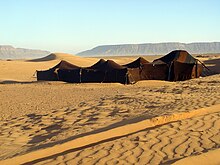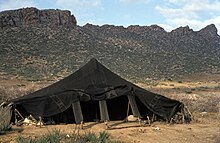Berber tent

A Berber tent ( Arabic الخيمة, DMG al-Haima ), Khaima, Haima or Khaimah is the traditional dwelling of the Berber - nomads in the south of the Maghreb -Staaten Morocco , Algeria , Tunisia and Libya . They probably existed before the first permanent settlements with houses made of rammed earth and stone.
Historical and sociocultural background
Well into the 20th century - in some cases even up to the present day - numerous Berber families led a nomadic or semi-nomadic life ( transhumance ) and wandered the country with their herds of cattle (donkeys, sheep, goats, more rarely camels) in search of cattle . While settling down gradually began in the oasis valleys , survival in the drier regions (especially in the Anti-Atlas ) was only possible if you had harvested barley and dried vegetables such as beans, peas and lentils, usually in March and April took place, with the cattle moved to the mountain regions of the High Atlas , where grasses, herbs and above all water were still available in sufficient quantities. They only returned to their native villages in late autumn; During the absence, the property was stored in communal warehouses ( Agadiren ) and defended against attacks by other nomads and hostile neighboring villages by a guards who stayed at home.
Tents
Manufacture and construction
On the way, people lived in tents that were easy to transport and quick to assemble and dismantle, made of black goat and brown camel hair, which the women woven on simple hip looms and sewn together from several strips about 50 cm wide and about 5 m long. The resulting wide tent sheet was usually stretched over at least six (often more) wooden sticks, of which the two middle ones were about 2 m high; the pegs on the side were mostly only 50 to 80 cm high. Overall, the tent was usually around 10 m wide and around 3 m deep. The tents primarily offered protection from strong winds and sandstorms, and also a little from the cool night; in the extremely rare rainfall, however, their benefits were limited. While the back of the tents, which is most exposed to the wind, was always closed, the panels of fabric hanging down at night were folded up during the day. Due to the way they were made, the Berber tents were always rectangular in length and thus differed significantly from the round tents ( yurts ) of Asian nomadic people.
decor
As purely functional buildings, Berber tents were mostly unadorned. In rare cases, there are woven patterns of triangles and diamonds, as can also be seen on many traditional houses made of rammed earth ( tighremts ) . These originally had a disastrous ( apotropaic ) meaning, but most of them have been forgotten and the joy of modest decor outweighs. On the sides and on the floor of the tents, carpets and blankets were regularly hung or laid out, which often showed similar motifs, but were generally more colorful.
present
(Semi) nomadism is dying out in most regions of the Maghreb - you only rarely see a few tents in the mountain or desert regions.
Many tourists spend one night in a tent camp in the desert in southern Morocco. The tents made available here are often modern products and no longer have anything to do with traditional Berber tents.

